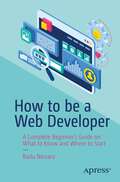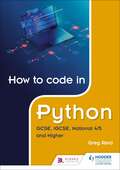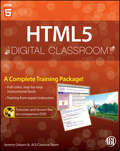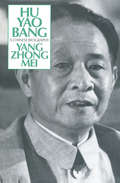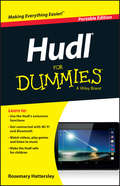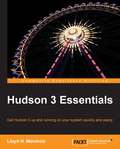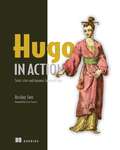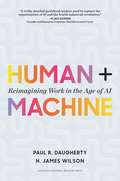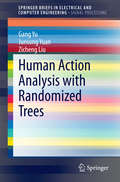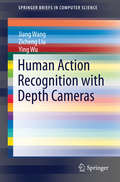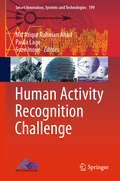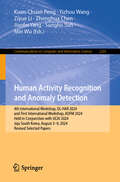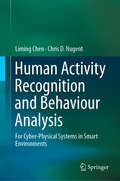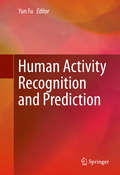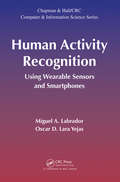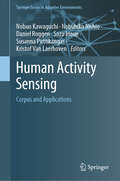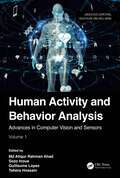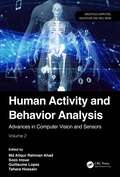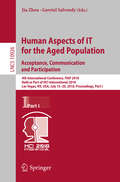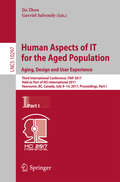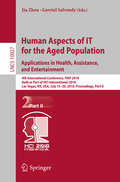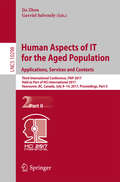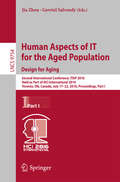- Table View
- List View
How to be a Web Developer: A Complete Beginner's Guide on What to Know and Where to Start
by Radu NicoaraThis complete beginner's guide is for anyone interested in becoming a web developer. Aimed at those without any previous experience, this book provides an overview of the key principles of modern web development.You'll gain insight into the key facets of JavaScript, HTML and CSS, as well as the difference between front-end, back-end, and full stack development. You'll also be introduced to popular tools and frameworks such as React, Angular, GraphQL, and Node.js, and gain an understanding of the role of a web developer: what it entails, how to secure your first role, and how to survive your first week in the job. Moreover, How to be a Web Developer will take you through the steps of building your first web application, allowing you to apply the principles you've learned in a practical way. Filled with additional information and resources, this book will give you the knowledge and tools needed to start your journey to becoming a professional web developer. What You Will LearnMaster the principles of JavaScript, HTML, CSS, and UX DesignUtilize tools and frameworks like React, Angular and GraphQLUnderstand what it means to be a web developer and what it entailsDevelop key soft skills such as teamwork and project managementGain practical knowledge that will help you get started as a web developerWho This Book Is ForComplete beginners without any previous knowledge or experience who are interested in web development.
How to code in Python: GCSE, iGCSE, National 4/5 and Higher
by Greg ReidEnsure every student can become fluent in Python with this highly practical guide that will help them understand the theory and logic behind coding.Written for 14-16-year olds by a leading Python specialist and teacher, and aligned to curriculum requirements, this essential Student Book provides numerous practice questions and coding problems that can be completed as homework or during class - plus answers can be found online at www.hoddereducation.co.uk/pythonextrasHow to Code in Python will:> Provide hundreds of coding examples, puzzles and problem-solving tasks to strengthen computational thinking skills required for GCSE, iGCSE and National 4 / 5 success> Help students become proficient in computational thinking and problem-solving using Python> Provide easy-to-follow explanations of concepts and terminology> Feature plenty of opportunities for self-assessment with solutions to coding problems available onlineThis unique book can be broken down into three key features:> Code theory and explanations (worked examples) in a fun and accessible way> Computational thinking puzzles for the reader to solve; this will greatly improve students' ability to read code and predict its effect and output when run> Programming problems where the reader has to write a program to solve given scenariosGreg Reid is a very experienced Computer Science teacher in Scotland, who has written How to Pass Higher Computer Science and Higher Computing Science Practice Papers for Hodder Gibson.
How to code in Python: GCSE, iGCSE, National 4/5 and Higher
by Greg ReidEnsure every student can become fluent in Python with this highly practical guide that will help them understand the theory and logic behind coding.Written for 14-16-year olds by a leading Python specialist and teacher, and aligned to curriculum requirements, this essential Student Book provides numerous practice questions and coding problems that can be completed as homework or during class - plus answers can be found online at www.hoddereducation.co.uk/pythonextrasHow to Code in Python will:> Provide hundreds of coding examples, puzzles and problem-solving tasks to strengthen computational thinking skills required for GCSE, iGCSE and National 4 / 5 success> Help students become proficient in computational thinking and problem-solving using Python> Provide easy-to-follow explanations of concepts and terminology> Feature plenty of opportunities for self-assessment with solutions to coding problems available onlineThis unique book can be broken down into three key features:> Code theory and explanations (worked examples) in a fun and accessible way> Computational thinking puzzles for the reader to solve; this will greatly improve students' ability to read code and predict its effect and output when run> Programming problems where the reader has to write a program to solve given scenariosGreg Reid is a very experienced Computer Science teacher in Scotland, who has written How to Pass Higher Computer Science and Higher Computing Science Practice Papers for Hodder Gibson.
Html5 Digital Classroom
by Agi Creative Team Jeremy OsbornThis training package - complete with full-color book and instructional video - is the easiest way to learn HTML5! HTML5 boasts extensive new features that allow you to create dynamic web pages and present users with amazing multimedia experiences, and this one-of-a-kind training package is your guide to creating websites that wow! HTML5 Digital Classroom provides step-by-step instruction to help you gain the essential HTML5 knowledge you need to master the latest HTML5 specifications. This book-and-video package will have you creating web pages and web applications using HTML5, styling using CSS3, and working effectively with JavaScript and jQuery like a pro. This personal training course uses a full-color book plus video tutorials to teach you how to design compelling websites and web apps, develop your coding skills, and take full advantage of the new web standards for creating rich multimedia experiences. This book starts at a foundational level with an introduction to HTML5 before moving on to more advanced topics like creating HTML5 forms, using geo location, implementing drag-and-drop, utilizing the Canvas element to create 2D and 3D graphics, and more. Includes 15 lessons in full-color covering introductory to advanced HTML5 topics plus video tutorials and sample files that allow you to test your skills and work at your own pace Fully updated for the latest HTML5 specifications and browser capabilities Covers the basics of creating web pages with HTML5, formatting text and layouts with CSS3, using web fonts, understanding HTML5 markup, and optimizing your site for viewing on mobile devices Explains more advanced concepts like working with video and audio, taking advantage of offline storage, using the Canvas element, enhancing your website with JavaScript and jQuery, and incorporating best practices for web coding into your workflow Get comfortable with writing and reviewing HTML5 compliant code and put your web development skills to work today with HTML5 Digital Classroom. NOTE: DVD and other supplementary materials are not included as part of eBook file. These materials are available for download upon purchase.
Hu Yao-Bang: A Chinese Biography
by Zhongmei YangCompares IT parks within the Asian Pacific in search of strategies that policy makers can adopt to: reduce the global digital divide; advance distributional equity; and soften some of the negative effects of economic globalization. "Best practices" are suggested based on these cases.
Hudl For Dummies
by Rosemary HattersleyThe essential beginner's guide to the UK's most popular new tabletHudl For Dummies is the indispensible guide to Tesco's highly successful Android tablet. With hands-on instruction tailored to the entry-level user, this book provides expert guidance in clear, concise language to help you get the most out of this great new device. Seasoned technology author Rosie Hattersley walks you through each step, from opening the box to setting up e-mail, accessing Blinkbox, shopping online and more. Even if you're a newcomer to tablet technology, this book will have you up and running in a flash!By utilizing groundbreaking technology, it's no wonder analysts expect the Hudl to become the UK's leading tablet. While the device itself is intuitive, the Hudl's infinite possibilities can be a bit of a mystery to new users. Hudl For Dummies is the definitive guide to the device, helping you access the full capabilities of your new tablet.Gain a complete understanding of how to get up and running with the Tesco HudlDownload and launch apps with your new tablet to make it a workhorse or an entertainment systemDiscover how to access the Internet, e-mail, films, music and booksShop online with your new device and find out how to buy Hudl accessoriesAn entire chapter on troubleshooting allows you to bypass the repair shop for minor issues, and gives you the confidence to adjust settings and preferences without the worry of messing something up. Whether you're transitioning to the Hudl from another tablet, or are new to tablets entirely, Hudl For Dummies will take you from a new user to full-fledged Hudl devotee.
Hudson 3 Essentials
by Lloyd H. MeinholzIf you are a Java developer or administrator who would to like automate some of the mundane work required to build and test software and improve software quality, this is the book for you. If you are a development manager or tester, you can also benefit from learning how Hudson works by gaining some insight into test results and historical trends.
Hugo in Action
by Atishay JainBuild and deploy a live website in just 30 minutes using Hugo. The Hugo engine lets you rapidly deliver static sites that are low maintenance, high performance, and feature rich. In Hugo in Action you will learn: Building web pages with Hugo and Jamstack Creating content using Markdown Content management with Hugo Designing new Hugo themes Using the Go template language Managing dependencies with Hugo modules Accessing APIs with Jamstack Adding a shopping cart using JavaScript Content tagging with markup Sometimes, simple is better. Static websites—sites with fixed content—are easier to create and maintain, and inherently more secure than dynamic pages. Hugo in Action is a hands-on guide to using the Hugo static site engine to render these websites in milliseconds. Working with a complete example website and source code samples, you&’ll learn how to build and host a site that will wow users and stay stable without a third-party server. Full coverage of the Jamstack (Javascript, APIs, Markdown) shows how easy it is to add complex features to super-simple sites, including eCommerce shopping carts, dynamic forms, and multilingual options. About the technology Because they load pre-built pages, static websites are simple, secure, and incredibly fast. With the Hugo static site generator you can build and render a website in seconds without the grind of hand coding the pages. Hugo takes a directory of content and templates and renders it as a full HTML and CSS website—perfect for blogs, documentation, and other sites that don&’t require real-time updates. About the book In Hugo in Action you&’ll learn step-by-step how to build efficient, low-maintenance static web sites. You&’ll use Hugo as a CMS and web development environment, create custom pages, and design your own Hugo themes. And you won&’t stop there! Moving beyond the basics, you&’ll incorporate the Jamstack model to add capabilities like eCommerce and your own APIs. The result: rich websites that are flexible and incredibly stable. What's inside Building web pages with Hugo and Jamstack Using the Go template language Managing dependencies with Hugo modules Content tagging with markup About the reader For web developers with a basic knowledge of JavaScript. About the author Atishay Jain is a Senior Computer Scientist at Adobe. He has developed web-based software used by millions of Adobe Creative Cloud customers. Table of Contents PART 1 STATIC HUGO WEBSITES: LOADING FAST, BUILDING TO LAST 1 The Jamstack and Hugo 2 Live in 30 minutes: You now have a website 3 Using markup for content 4 Content management with Hugo 5 Custom pages and customized content with the Go template language 6 Structuring web pages 7 Creating your own theme 8 Hugo Modules: Plugins for everybody PART 2 EXPANDING WITH THE JAMSTACK: DYNAMIC OUTSIDE, STATIC INSIDE 9 Accessing APIs to enhance functionality 10 The power of JavaScript 11 Breaking barriers with custom APIs and webhooks 12 Adding e-commerce capabilities using the Jamstack 13 Wrapping it up
Human + Machine: Reimagining Work In The Age Of AI
by H. James Wilson Paul R. DaughertyIn Human + Machine, Accenture leaders Paul R. Daugherty and H. James (Jim) Wilson show that the essence of the AI paradigm shift is the transformation of all business processes within an organization--whether related to breakthrough innovation, everyday customer service, or personal productivity habits. As humans and smart machines collaborate ever more closely, work processes become more fluid and adaptive, enabling companies to change them on the fly--or to completely reimagine them. AI is changing all the rules of how companies operate. <p><p> Based on the authors' experience and research with 1,500 organizations, the book reveals how companies are using the new rules of AI to leap ahead on innovation and profitability, as well as what you can do to achieve similar results. It describes six entirely new types of hybrid human + machine roles that every company must develop, and it includes a "leader’s guide" with the five crucial principles required to become an AI-fueled business. <p> Human + Machine provides the missing and much-needed management playbook for success in our new age of AI.
Human Action Analysis with Randomized Trees
by Zicheng Liu Gang Yu Junsong YuanThis book will provide a comprehensive overview on human action analysis with randomized trees. It will cover both the supervised random trees and the unsupervised random trees. When there are sufficient amount of labeled data available, supervised random trees provides a fast method for space-time interest point matching. When labeled data is minimal as in the case of example-based action search, unsupervised random trees is used to leverage the unlabelled data. We describe how the randomized trees can be used for action classification, action detection, action search, and action prediction. We will also describe techniques for space-time action localization including branch-and-bound sub-volume search and propagative Hough voting.
Human Action Recognition with Depth Cameras
by Ying Wu Jiang Wang Zicheng LiuAction recognition technology has many real-world applications in human-computer interaction, surveillance, video retrieval, retirement home monitoring, and robotics. The commoditization of depth sensors has also opened up further applications that were not feasible before. This text focuses on feature representation and machine learning algorithms for action recognition from depth sensors. After presenting a comprehensive overview of the state of the art, the authors then provide in-depth descriptions of their recently developed feature representations and machine learning techniques, including lower-level depth and skeleton features, higher-level representations to model the temporal structure and human-object interactions, and feature selection techniques for occlusion handling. This work enables the reader to quickly familiarize themselves with the latest research, and to gain a deeper understanding of recently developed techniques. It will be of great use for both researchers and practitioners.
Human Activity Recognition Challenge (Smart Innovation, Systems and Technologies #199)
by Sozo Inoue Md Atiqur Rahman Ahad Paula LagoThe book introduces some challenging methods and solutions to solve the human activity recognition challenge. This book highlights the challenge that will lead the researchers in academia and industry to move further related to human activity recognition and behavior analysis, concentrating on cooking challenge. Current activity recognition systems focus on recognizing either the complex label (macro-activity) or the small steps (micro-activities) but their combined recognition is critical for analysis like the challenge proposed in this book. It has 10 chapters from 13 institutes and 8 countries (Japan, USA, Switzerland, France, Slovenia, China, Bangladesh, and Columbia).
Human Activity Recognition and Anomaly Detection: 4th International Workshop, DL-HAR 2024, and First International Workshop, ADFM 2024, Held in Conjunction with IJCAI 2024, Jeju, South Korea, August 3–9, 2024, Revised Selected Papers (Communications in Computer and Information Science #2201)
by Yizhou Wang Min Wu Zhenghua Chen Kuan-Chuan Peng Ziyue Li Jianfei Yang Sungho SuhThis book constitutes the refereed proceedings of the 4th International and First International Workshop on Human Activity Recognition and Anomaly Detection, Conjunction with IJCAI 2024, held in Jeju, South Korea, during August 3–9, 2024. The 9 full papers included in this book were carefully reviewed and selected from 14 submissions. They were organized in topical sections as follows: Anomaly Detection with Foundation Models and Deep Learning for Human Activity Recognition.
Human Activity Recognition and Behaviour Analysis: For Cyber-Physical Systems in Smart Environments
by Chris D. Nugent Liming ChenThe book first defines the problems, various concepts and notions related to activity recognition, and introduces the fundamental rationale and state-of-the-art methodologies and approaches. It then describes the use of artificial intelligence techniques and advanced knowledge technologies for the modelling and lifecycle analysis of human activities and behaviours based on real-time sensing observations from sensor networks and the Internet of Things. It also covers inference and decision-support methods and mechanisms, as well as personalization and adaptation techniques, which are required for emerging smart human-machine pervasive systems, such as self-management and assistive technologies in smart healthcare. Each chapter includes theoretical background, technological underpinnings and practical implementation, and step-by-step information on how to address and solve specific problems in topical areas.This monograph can be used as a textbook for postgraduate and PhD students on courses such as computer systems, pervasive computing, data analytics and digital health. It is also a valuable research reference resource for postdoctoral candidates and academics in relevant research and application domains, such as data analytics, smart cities, smart energy, and smart healthcare, to name but a few. Moreover, it offers smart technology and application developers practical insights into the use of activity recognition and behaviour analysis in state-of-the-art cyber-physical systems. Lastly, it provides healthcare solution developers and providers with information about the opportunities and possible innovative solutions for personalized healthcare and stratified medicine.
Human Activity Recognition and Prediction
by Yun FuThis book provides a unique view of human activity recognition, especially fine-grained human activity structure learning, human-interaction recognition, RGB-D data based action recognition, temporal decomposition, and causality learning in unconstrained human activity videos. The techniques discussed give readers tools that provide a significant improvement over existing methodologies of video content understanding by taking advantage of activity recognition. It links multiple popular research fields in computer vision, machine learning, human-centered computing, human-computer interaction, image classification, and pattern recognition. In addition, the book includes several key chapters covering multiple emerging topics in the field. Contributed by top experts and practitioners, the chapters present key topics from different angles and blend both methodology and application, composing a solid overview of the human activity recognition techniques.
Human Activity Recognition: Using Wearable Sensors and Smartphones (Chapman & Hall/CRC Computer and Information Science Series)
by Miguel A. Labrador Oscar D. Lara YejasLearn How to Design and Implement HAR Systems The pervasiveness and range of capabilities of today's mobile devices have enabled a wide spectrum of mobile applications that are transforming our daily lives, from smartphones equipped with GPS to integrated mobile sensors that acquire physiological data. Human Activity Recognition: Using Wearable Sen
Human Activity Sensing: Corpus and Applications (Springer Series in Adaptive Environments)
by Sozo Inoue Nobuo Kawaguchi Nobuhiko Nishio Daniel Roggen Susanna Pirttikangas Kristof Van LaerhovenActivity recognition has emerged as a challenging and high-impact research field, as over the past years smaller and more powerful sensors have been introduced in wide-spread consumer devices. Validation of techniques and algorithms requires large-scale human activity corpuses and improved methods to recognize activities and the contexts in which they occur. This book deals with the challenges of designing valid and reproducible experiments, running large-scale dataset collection campaigns, designing activity and context recognition methods that are robust and adaptive, and evaluating activity recognition systems in the real world with real users.
Human Activity and Behavior Analysis: Advances in Computer Vision and Sensors: Volume 1 (Ubiquitous Computing, Healthcare and Well-being)
by Md Atiqur Rahman AhadHuman Activity and Behavior Analysis relates to the field of vision and sensor-based human action or activity and behavior analysis and recognition. The book includes a series of methodologies, surveys, relevant datasets, challenging applications, ideas, and future prospects.The book discusses topics such as action recognition, action understanding, gait analysis, gesture recognition, behavior analysis, emotion and affective computing, and related areas. This volume focuses on relevant activities in three main subject areas: Healthcare and Emotion, Mental Health, and Nurse Care Records.The editors are experts in these arenas and the contributing authors are drawn from high-impact research groups around the world. This book will be of great interest to academics, students, and professionals working and researching in the field of human activity and behavior analysis.
Human Activity and Behavior Analysis: Advances in Computer Vision and Sensors: Volume 2 (Ubiquitous Computing, Healthcare and Well-being)
by Guillaume Lopez Sozo Inoue Md Atiqur Rahman Ahad Tahera HossainHuman Activity and Behavior Analysis relates to the field of vision and sensor-based human action or activity and behavior analysis and recognition. The book includes a series of methodologies, surveys, relevant datasets, challenging applications, ideas, and future prospects.The book discusses topics such as action recognition, action understanding, gait analysis, gesture recognition, behavior analysis, emotion and affective computing, and related areas. This volume focuses on two main subject areas: Movement and Sensors, and Sports Activity Analysis.The editors are experts in these arenas, and the contributing authors are drawn from high-impact research groups around the world. This book will be of great interest to academics, students, and professionals working and researching in the field of human activity and behavior analysis.
Human Aspects in Ambient Intelligence
by Diane J. Cook Tibor Bosse Mark Neerincx Fariba SadriThis book presents recent developments is the field of human aspects in Ambient Intelligence. This field, and the associated workshop series, addresses multidisciplinary aspects of AmI with human-directed disciplines such as psychology, social science, neuroscience and biomedical sciences. The aim of the workshop series is to get researchers together from these human-directed disciplines or working on cross connections of AmI with these disciplines. The focus is on the use of knowledge from these disciplines in AmI applications, in order to support humans in their daily living in medical, psychological and social respects. The book plays important role to get modellers in the psychological, neurological, social or biomedical disciplines interested in AmI as a high-potential application area for their models. From the other side, the book may make researchers in Computer Science and Artificial and Ambient Intelligence more aware of the possibilities to incorporate more substantial knowledge from the psychological, neurological, social and biomedical disciplines in AmI architectures and applications.
Human Aspects of IT for the Aged Population. Acceptance, Communication and Participation: 4th International Conference, ITAP 2018, Held as Part of HCI International 2018, Las Vegas, NV, USA, July 15–20, 2018, Proceedings, Part I (Lecture Notes in Computer Science #10926)
by Gavriel Salvendy Jia ZhouThis book constitutes the proceedings of the 4th International Conference onHuman Aspects of IT for the Aged Population, ITAP 2018, held as part of the 20th International Conference, HCI International 2018, which took place in Las Vegas, Nevada, in July 2018.The total of 1171 papers and 160 posters included in the 30 HCII 2018 proceedings volumes was carefully reviewed and selected from 4346 submissions. ITAP 2018 includes a total of 84 papers. They were organized in topical sections as follows: Part I: aging and technology acceptance; aging and interaction; intergenerational communication and social participation. Part II: health care technologies and services for the elderly; intelligent environments for aging; and games and entertainment for the elderly.
Human Aspects of IT for the Aged Population. Aging, Design and User Experience
by Gavriel Salvendy Jia ZhouThe two-volume set LNCS 10297 + 10298 constitutes the refereed proceedings of the Third International Conference on Human Aspects of IT for the Aged Population, ITAP 2017, held as part of HCI International 2017 in Vancouver, BC, Canada. HCII 2017 received a total of 4340 submissions, of which 1228 papers were accepted for publication after a careful reviewing process. The 83 papers presented in the two volumes of ITAP 2017 were organized in topical sections as follows: Part I: aging and technology acceptance; user-centred design for the elderly; product design for the elderly; aging and user experience; digital literacy and training. Part II: mobile and wearable interaction for the elderly; aging and social media; silver and intergenerational gaming; health care and assistive technologies and services for the elderly; aging and learning, working and leisure.
Human Aspects of IT for the Aged Population. Applications in Health, Assistance, and Entertainment: 4th International Conference, ITAP 2018, Held as Part of HCI International 2018, Las Vegas, NV, USA, July 15–20, 2018, Proceedings, Part II (Lecture Notes in Computer Science #10927)
by Gavriel Salvendy Jia ZhouThis book constitutes the proceedings of the 4th International Conference onHuman Aspects of IT for the Aged Population, ITAP 2018, held as part of the 20th International Conference, HCI International 2018, which took place in Las Vegas, Nevada, in July 2018. The total of 1171 papers and 160 posters included in the 30 HCII 2018 proceedings volumes was carefully reviewed and selected from 4346 submissions. ITAP 2018 includes a total of 84 papers. They were organized in topical sections as follows: Part I: aging and technology acceptance; aging and interaction; intergenerational communication and social participation. Part II: health care technologies and services for the elderly; intelligent environments for aging; and games and entertainment for the elderly.
Human Aspects of IT for the Aged Population. Applications, Services and Contexts
by Gavriel Salvendy Jia ZhouThe two-volume set LNCS 10297 + 10298 constitutes the refereed proceedings of the Third International Conference on Human Aspects of IT for the Aged Population, ITAP 2017, held as part of HCI International 2017 in Vancouver, BC, Canada. HCII 2017 received a total of 4340 submissions, of which 1228 papers were accepted for publication after a careful reviewing process. The 83 papers presented in the two volumes of ITAP 2017 were organized in topical sections as follows: Part I: aging and technology acceptance; user-centred design for the elderly; product design for the elderly; aging and user experience; digital literacy and training. Part II: mobile and wearable interaction for the elderly; aging and social media; silver and intergenerational gaming; health care and assistive technologies and services for the elderly; aging and learning, working and leisure.
Human Aspects of IT for the Aged Population. Design for Aging
by Gavriel Salvendy Jia ZhouThe two LNCS volume set 9193-9194 constitutes the refereed proceedings of the First International Conference on Human Aspects of IT for the Aged Population, ITAP 2015, held as part of the 17th International Conference on Human-Computer Interaction, HCII 2015, held in Los Angeles, CA, USA, in August 2015, jointly with 15 other thematically conferences. The total of 1462 papers and 246 posters presented at the HCII 2015 conferences were carefully reviewed and selected from 4843 submissions. These papers of the two volume set address as follows: LNCS 9193, Design for Aging (Part I), addressing the following major topics: HCI design and evaluation methods for the elderly; ICT use and acceptance; aging, the web and social media; and the elderly and mobile devices and LNCS 9194, Design for Everyday Life (Part II), addressing the following major topics: health care technologies and services for the elderly; home and work support; smart environment and AAL; and communication, games, and entertainment.
